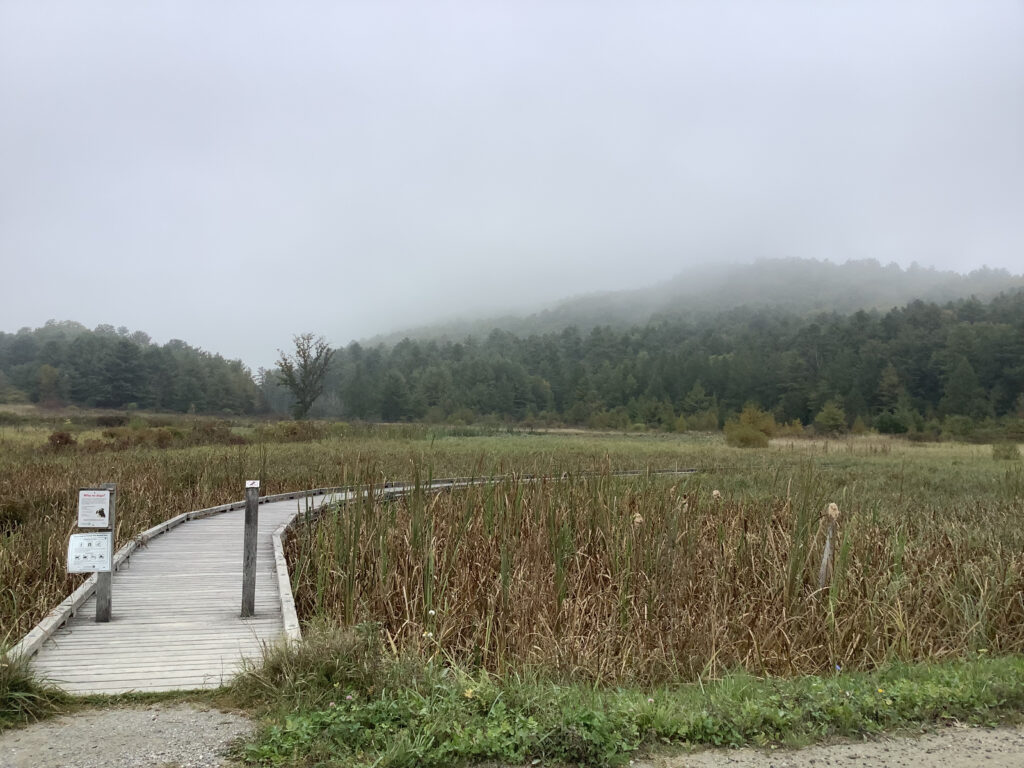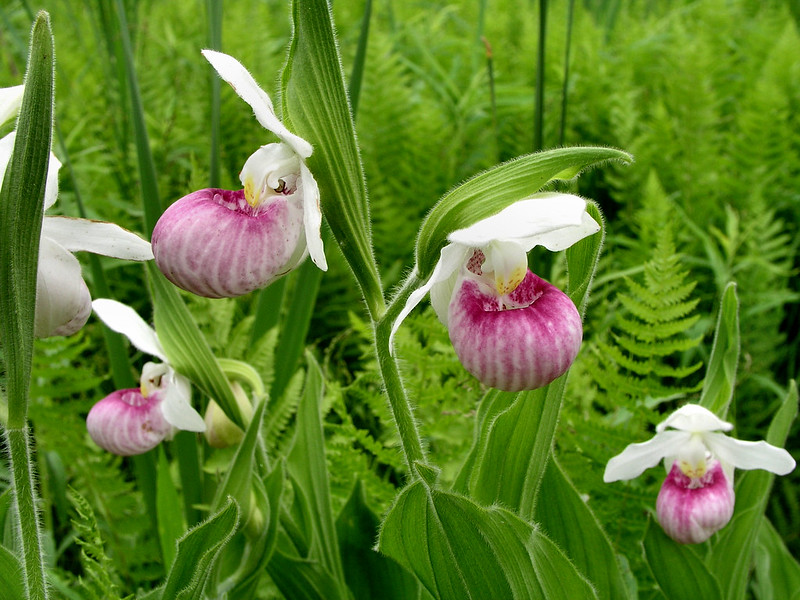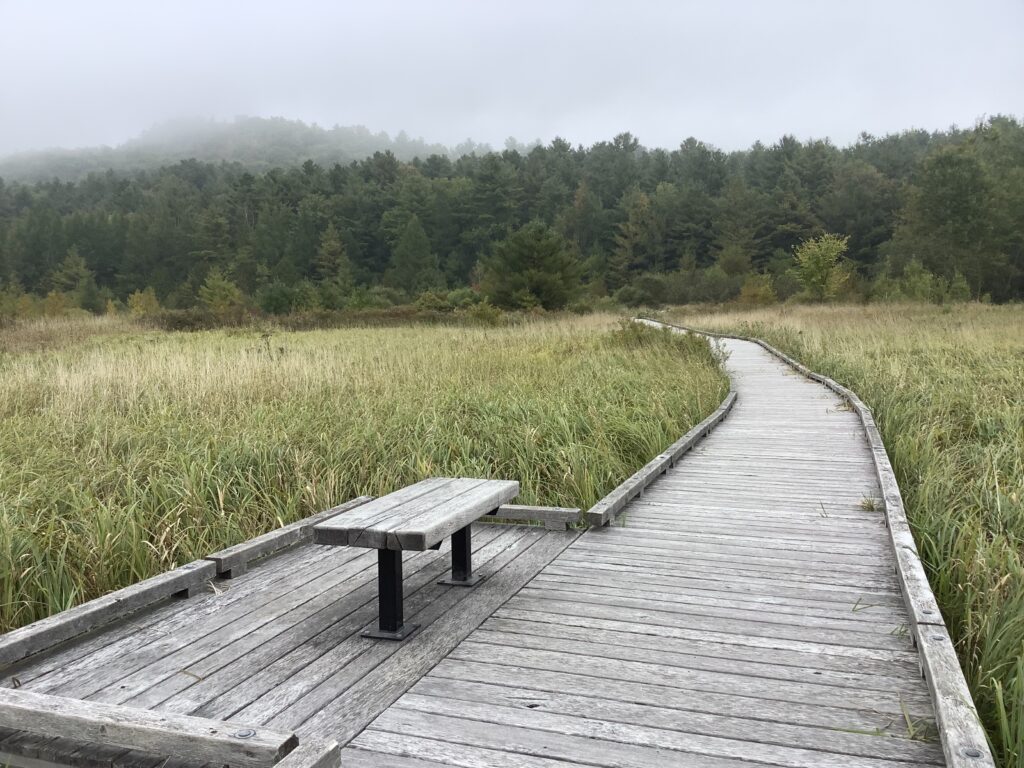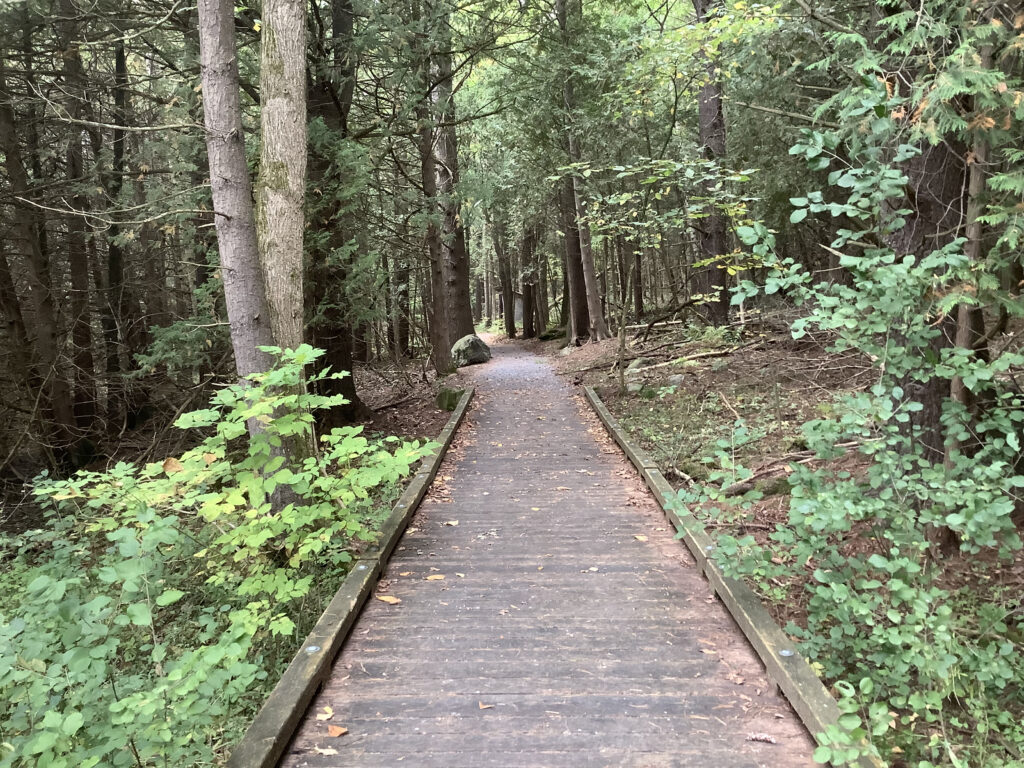Podcast: Play in new window | Download (Duration: 27:40 — 50.7MB)
Get new episodes by email RSS
In this episode of Green Mountain Disability Stories, we welcome Lynn McNamara, from the Nature Conservancy Vermont. Lynn joins CDCI Communications Manager Audrey Homan to talk about what the Nature Conservancy Vermont learned in building accessible natural outdoor areas in Monkton, and Hartland Vermont.
“I think the trails that we’ve improved accessibility on also seem to protect the natural features more. We’ve found that our accessible trails and boardwalks hold up better to increased traffic. We have less erosion, and even with some of the storms that we’ve had in the last couple of years, they hold up better because they’re designed to have better drainage so that the surface stays level and firm for folks with disabilities. But it’s also protecting the natural areas around them a little better.”
Lynn is the family member of someone with a disability.
A full transcript for the episode appears below. You can also download the transcript.
Audrey Homan: Welcome to Green Mountain Disability Stories. Today on the show, I have Lynn McNamara, who is going to talk to us about some accessibility challenges that have come up in Vermont, in Vermont’s outdoor natural areas. And Lynn is something of an expert in this area. So Lynn, can you go ahead and introduce yourself? Tell us your name, your pronouns, what town you live or work in and give us a brief verbal description of yourself.
Lynn McNamara: Sure. So my name is Lynn McNamara and I use she/her pronouns. I’m the Stewardship Director at The Nature Conservancy based out of our Montpelier office. So I’m responsible for overseeing the management and monitoring of all of our conserved lands here in Vermont.
Audrey: Fantastic. And can you tell us a little bit more about how your stewardship position interacts with access to those lands?
Lynn: Sure. So to start with a little more about The Nature Conservancy, which I will try not to use acronyms, but if I say TNC, I’m referring to The Nature Conservancy, which is a global organization and we’re focused on protecting the lands and waters on which all life depends. And we do that in many ways all around the world from things like investing in water funds in Belize to supporting climate smart forestry practices, restoring American bison in the Great Plains.
And here in Vermont, we own and manage about 57 natural areas that protect rare species or natural communities, do things like improve habitat connectivity for wildlife, but also provide opportunities for people to connect with nature. We think one of the most important ways to get people to support our work and care about conservation is to get out and experience nature.
So as the Stewardship Director, my role is to maintain or improve the condition of these special places that we’ve protected and at the same time, provide a safe and welcoming experience for visitors. And so that also intersects with disability access because we want to, as much as we can, make these places accessible for everyone.
Audrey: Thank you. Now, can you tell me a little bit about your own experience with disability in Vermont as a family member of someone with a disability?
Lynn: Yeah. So in my 25 years or so of living in Vermont, I’ve been so happy to see how much improvement has been to disability access over the years, particularly in the outdoors. The efforts in the last five to 10 years to have more accessible trails across the state has been really wonderful and has made it possible for me to get out in nature with my stepfather who has a mobility disability. So as a kid, we did lots of outdoor activities like hiking and fishing and biking, but after my dad injured his back, those things were no longer possible. And when I first moved to Vermont after college, getting around and seeing the state was really difficult for him, especially in winter when snow and ice can make otherwise accessible areas, even sidewalks, really treacherous and sometimes just not possible. But I feel like that’s slowly improved.
And especially in the last few years, it’s been great to bring him to some places that have accessible trails like Raven Ridge or the Barnes Camp Boardwalk up in Smuggler’s Notch. So I feel like things have really been improving fairly recently.

Audrey: So have your dad’s experiences influenced how you approach your stewardship work with The Nature Conservancy?
Lynn: Yeah, they definitely have. I think the first time I brought him out to visit one of our preserves, I don’t remember, it was maybe five years, it was before COVID, probably five years ago or so, but I’ve been working at The Nature Conservancy for almost 18 years and so he wasn’t able to see my work before then. Not really. I’d send pictures and things.
But I think like most dads, he’s proud of what I do. And being able to show him firsthand was just really special for me.
And it definitely has made me think more about what can I do to make these places more accessible for as many people as possible? I think it’s easy for folks to think like,
“Well, Vermont is very hilly and steep and there’s no way that could be accessible.”
And yes, a lot of places in Vermont are hilly and steep, but there’s a lot that are not and there’s many ways to improve accessibility for a variety of disabilities. It’s not always just for mobility access.
Audrey: Now, The Nature Conservancy of Vermont has done work in the area of making some of the natural outdoor areas more accessible for people with mobility disabilities. Can you talk a little bit about what some of those processes have been like?
Lynn: Yeah. Well, when we first started thinking about improving accessibility was probably maybe around 2012. And that started with our Eshqua Bog Natural Area, which is in Hartland, Vermont, just a few miles outside of downtown Woodstock. And it was one of our most visited natural areas.
It’s beautiful bog, really it’s a fen, but it’s called a bog, that is home to thousands probably of showy lady’s slippers that bloom every June. And we had an old boardwalk there that was built before my time, I’m not quite sure when, but it had slowly been heaving and was sinking into the bog. It had no railings or bumpers and it could get pretty slippery.

And as it deteriorated, we also began hearing from visitors that it was no longer possible for them to visit with their parents or grandparents who loved to see the showy lady’s slippers.
So when it was time to replace the boardwalk, I pushed hard to make sure that it met accessibility guidelines so that it would be welcoming for everyone, but it would also provide increased protection for the rare plants that live in the bog because it wouldn’t be sinking into the bog anymore. We were going to raise it up to get a little more light to improve the habitat for the plants.
And that also meant people were less likely to step off the boardwalk into the bog and not trample plants as much.
But this was a huge learning experience for me. I really had no idea what I was getting into. I’m like:
“Oh, we’ll just replace the boardwalk, no big deal.”
But there’s a lot of permitting involved that I wasn’t prepared for. So while the project sounded great, it took probably a year longer than planned just to complete the permitting and the fundraising that we needed to do.
But in the end, we were able to raise the money through we had a state recreation trails program grant, we had some private foundations who supported the project as well as a lot of fundraising just through individual gifts.
There were a lot of people who really support that kind of accessibility project. So even though the price tag was pretty big, I think in around 2013 when that happened, that project probably cost I want to say around $125,000, which was definitely probably the biggest stewardship project we had ever done on one of our preserves. But it’s been a wonderful success and we’ve had so much gratitude from folks that live nearby, plus folks that have traveled really from great distances to out there and visit.

It’s just really been a wonderful experience all around.
Audrey: What’s one thing you’d really like listeners to know about your work with The Nature Conservancy expanding accessibility in Vermont’s outdoor natural areas?
Lynn: I think not just for The Nature Conservancy expanding, but for so many state agencies and municipalities and Green Mountain National Forest, there are so many people working to expand accessibility to nature in Vermont right now. And I think people should not be resigned that they’re not welcome in nature, that there are a lot of people across the state who are working to improve accessibility all over the place. And while sometimes it can be difficult to find the places that are accessible just because
I’m not really aware of one sort of repository that can tell you where they’re… Trailfinder and AllTrails have filters, but I feel like they’re not always super accurate. But I would tell people to not only find those places, but also continue to push for increased accessibility and improved access routes and public transportation to those places so that you’re able to get out there.
If your town has a park or a town forest, talk to the select border or city council if you live in a city about improving accessibility and see if you can get involved in the public process to really help your voice be heard. Access to nature has been shown to have great benefits both for mental and physical health and that’s important for everyone.
Audrey: I absolutely agree. Are you getting a lot of feedback on your work with the bog area? Are you getting a lot of feedback from people with disabilities on ways that they’re enjoying the upgrades that have been or ways that they’re still pushing for additional access?
Lynn: Yeah, we’ve had a lot of feedback both at Eshqua Bog and our Raven Ridge natural area that’s in Moncton that has an accessible boardwalk and trail that ends at a beaver pond, so there’s a little wildlife viewing platform there. And we get a lot of feedback that people are so happy that it’s accessible, but not just from folks with disabilities. Improving access for disabilities really improves the experience for everyone.
So we hear from families with small children or people who’ve never really been out hiking much. Having a nice wide safe trail can be much more welcoming than a very primitive narrow trail to somebody who’s never really been out. So we’ve had great feedback.
And we’ve also put up some trail counters, we’re trying to measure improvements in visitation. And in places where we’ve improved accessibility, we generally probably have gotten like three to four times as many visitors once the trail is improved.
Audrey: I hadn’t realized that the improvements generated that much more interest. That’s amazing.
When the Nature Conservancy was going through this process of having to learn about accessible trails and accessible pathways and walkways, were there some ways in which you felt like Vermont as a place or state was supportive of the efforts that the improvements that the Nature Conservancy was trying to make?
Lynn: Yeah. I know I talked about the permitting processes previously, which were at first a little overwhelming to me because I hadn’t really done that before. And in both of the places we’ve created accessible trails required Act 250 permits and I know I say that and it might scare people. But the Act 250 permit process, we need wetlands permits as well, the staff at the state, the permitting staff, were very supportive of these projects. I think for them, it was wonderful to see somebody trying to improve accessibility, even if it was in a wetland. So they wanted to make sure that we were able to navigate the permit process well. And so we had a lot of supports from the regulatory folks.
So I would say: don’t be afraid of the permitting process.
Yes, those permits can seem daunting, but it wasn’t so bad. Same with fundraising. The cost of some of these can also seem overwhelming, but we’ve really had great success in fundraising for these projects. There’s state funding, there’s private grants available and there’s just a lot of private donors who are interested in supporting these kind of projects.
Audrey: I think the flip side of that question is when you were going through this process with The Nature Conservancy of Vermont, were there any ways that you felt like Vermont was particularly forwarding the process or there are spaces in which Vermont could create friendlier systems for these accessibility upgrades?
Lynn: Of course, fundraising. Yes, fundraising is easy, but these projects are also very expensive. So having more sources of funding that are larger.
Sometimes I think the Recreation Trails program grants about $50,000, and honestly, that doesn’t go all that far for some of these projects. But some of the more recent grants, like the VOREC grants at the state that have an accessibility focus, those are a bigger chunk of money. So from a fundraising perspective, it’s really great to get a big chunk of money, especially at the start of a project because that can help bring in some smaller gifts to finish up the project.
Also, one thing, as I mentioned earlier, that I think would be great in Vermont would be to have a central place where people could go to find where these accessible trails are located. And I’m just not aware of if there is a place, I’m not sure if you are, or more accurate information on AllTrails or Trailfinder, just a place where people could just if you’re looking to get out in nature, you could find a nice list with links, I think that would be great.
Audrey: It’s interesting that you mentioned the VOREC grants because one of the VOREC grants went to the Vermont Trails and Greenways Council. And their project is actually to build a hub, a website that pulls all the information about accessible trails together into one place. So that exactly what you said, you can look up your favorite place before you head out there to see if the trails are going to meet your needs.
Lynn: Oh, that’s wonderful to hear.
Audrey: Yeah. Obviously, we hope that all trails become eventually accessible because earlier you were talking about how the feedback you’d gotten came not just from people with accessibilities, but also from people pushing strollers, that comes under the heading of a situational disability, having to navigate that stroller over rocky terrain or through a narrow dirt corridor between high grasses. But it’s just as important for those people and that family to get access to that natural area as it is for someone in a wheelchair or someone using a cane to also be able to navigate that trail.
Lynn: Yes, definitely.
Audrey: So what’s one thing you wish you had known about disability or about Vermont or both 10 years ago?
Lynn: I think one thing we’ve really seen is how improving disability access improves access for everyone. And I really hadn’t realized that prior to working on these projects. But as we said, in addition for folks with say situational disability like people with kids in strollers, I think these accessible trails and boardwalks can really provide different opportunities. We often see photographers or other artists out there setting up on the boardwalk and it just makes for an overall more welcoming experience for everybody to get out in nature.
And I think the trails that we’ve improved accessibility on also seem to protect the natural features more. We’ve found that our accessible trails and boardwalks hold up better to increase traffic. We have less erosion. And even with some of the storms that we’ve had in the last couple years, they hold up better because they’re designed to have better drainage so that the surface stays level and firm for folks with disabilities, but it’s also protecting the natural areas around them a little better.

Audrey: I love hearing that. I had no idea that the more accessible trails actually were sort of more fiscally responsible because they need to be replaced fewer times than previously.
I’m wondering because I live in Hinesburg, where as a town, we’re talking about building a green space in the middle of town that is for everyone’s enjoyment. And so far, the biggest topic of contention has been the walkways because people want paths that go through this green space that are technically accessible but also fiscally responsible because everybody is having this conversation around the way that towns and municipalities use tax monies.
So what’s one piece of advice you could give to someone living in Hinesburg or someone in a town that has a similar situation going on where they’re trying to have these discussions with the select boards and with other townspeople? What’s one piece of advice you have for those people in terms of advocating for accessible trails and walkways?
Lynn: I think yes, money is always going to be contentious, but that shouldn’t be the primary deciding factor on whether these spaces truly are going to be for everybody. There are grants that municipalities are eligible for. And I think maybe towns are a little more fiscally conservative. There’s always going to be loud voices on every side of when money and taxes, property taxes, come up.
But I would say I think towns have a responsibility to everybody and maybe even more so to folks with disabilities. For many years, folks with disabilities and others were disenfranchised a bit and didn’t have a voice. And I think now we do. And it’s important for towns to advocate for everybody in their town.
Audrey: I love that. I love the idea that people with disabilities are a constant presence in conversations around building these natural areas at the town level.
I love that that should be standard when you’re having conversations with the select board to remember that people with disabilities are part of every single community.
So a couple last questions and then I’ll let you go because I know you’re super busy. But has your dad been out to see the lady’s slippers yet?
Lynn: He has not and I’m not sure why. I think they generally bloom around June 21st, which just always feels like a very busy time of year for everybody. He lives in Massachusetts and it just hasn’t worked out to go there. But I have taken him to Raven Ridge and he’s been to the Barnes Camp Boardwalk up in Smuggler’s Notch and really enjoyed that as well. So next year for sure, we’ll make sure we get to Eshqua Bog to see the lady’s slippers.
Audrey: Excellent news. And then the last question I have is simply if you have any one piece of advice for other disability advocacy organizations or other outdoor natural area advocacy organizations on where to start with pushing forward with accessibility in the natural outdoor areas around them? Do you have any one piece of advice you could offer?
Lynn: I would say for folks that are involved in making spaces more accessible, for managing these places, is to not be afraid. As I said, I had zero experience when I started working on this 12 years ago or so. If I could do it, anybody could do it. There’s a lot of help out there. There’s a lot of resources at the state. There are grants.
And I’m happy to talk with folks if you want to reach out to me for more details about some of the projects I’ve worked on. And I think this is something that’s really important for Vermont, for Vermonters. And having advocates, both who are managing lands and who want to get out more, will just continue to improve accessibility for everybody.
Audrey: Amen to that. Really love that.
Lynn: Great.
Audrey: Lynn McNamara, thank you for joining us from The Nature Conservancy Vermont to talk about accessibility in Vermont’s natural outdoor spaces on Green Mountain Disability Stories.
Lynn: Thank you, Audrey. It’s been my pleasure.